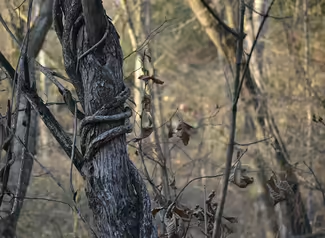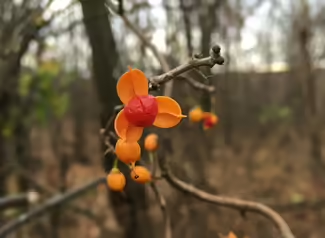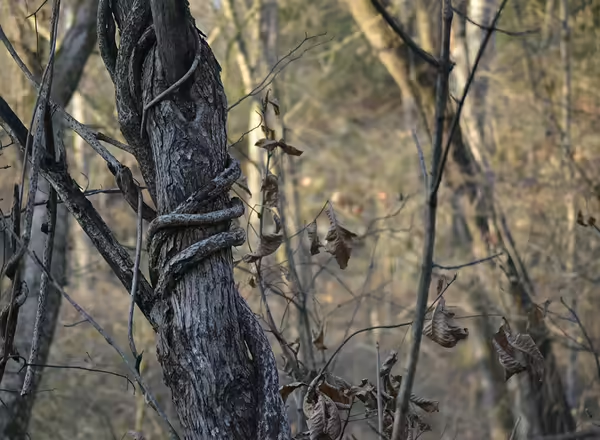
Invasive Roundleaf Bittersweet
Roundleaf bittersweet (Celastrus orbiculatus), also known as Oriental bittersweet, is a woody vine that grows very tightly around other vegetation, girdling it in the process. It can weigh down the trees and shrubs it grows on, causing limbs to break, and it also shades out other native vegetation.

Roundleaf bittersweet was introduced from Asia in the 1860s as an ornamental plant. Its colorful berries made it an attractive choice for fall home decor, such as wreaths.
Regulation of Roundleaf Bittersweet
Roundleaf bittersweet is regulated under the Illinois Exotic Weed Act.
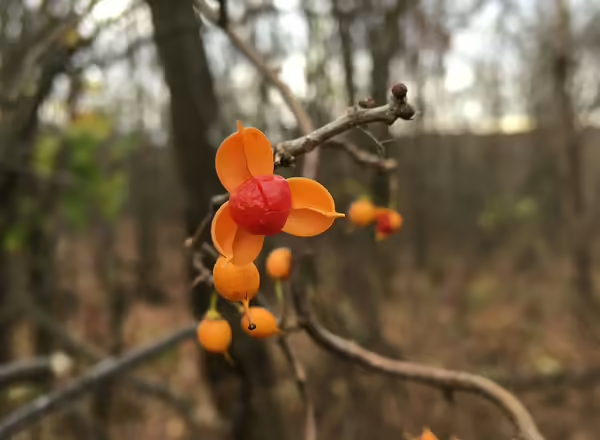
Roundleaf bittersweet is a woody vine that can grow over 60 feet long. It has rounded leaves that are toothed and have pointed tips. The leaves are alternately arranged along the stem. They turn yellow in the fall. This plant is dioecious, which means there are separate male and female plants. Female plants will produce axillary clusters of green flowers in late spring to early summer. Axillary flowers occur along the stem of the plant, rather than at the tip of a branch. The flowers are replaced by green fruits in the summer that mature into yellow-orange capsules. The capsules break open in fall to winter to reveal a red fruit inside.
There is a native species called American bittersweet, Celastrus scandens, that looks similar. The flowers of American bittersweet occur in terminal clusters, meaning they are only found at the tip of a branch, rather than along the stems. The capsules of American bittersweet are dark orange in color, rather than more yellow orange in roundleaf bittersweet.
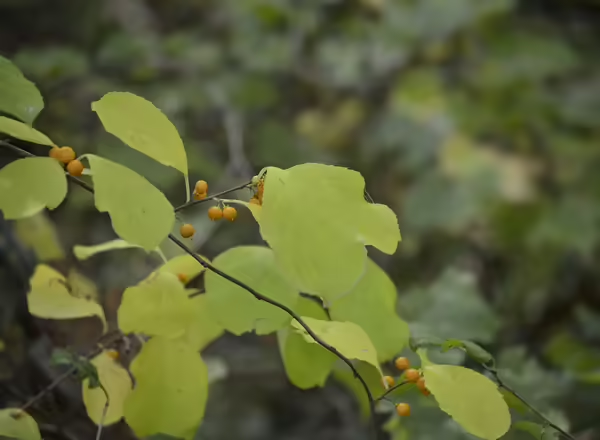
- Mechanical control: Seedlings may be pulled by hand, but the root is difficult to remove completely, which will lead to re-sprouting.
- Fire: Prescribed fire may kill seedlings but will top kill larger plants, which will stimulate root suckering. Fire without integrated treatment with herbicides may increase stem density by two to three times.
- Chemical control: Always read and follow the herbicide label before initiating treatment.
- Apply 2% v/v glyphosate in water or 1% to 3% v/v triclopyr in water to healthy foliage.
- Basal bark: Apply 20% to 30% v/v solution of triclopyr ester in basal oil.
- Cut stump: Cutting the stem will stimulate root suckering (sprouting), increasing stem density. Cutting should not be done without applying herbicide, but herbicide may not translocate to the end of the root system. A 10% to 20% solution of triclopyr or a 20% to 25% solution of glyphosate can be used with follow up monitoring to ensure herbicide translocation.
For more information, explore Management of Invasive Plants and Pests of Illinois.
Invasive shrubs, trees, and vines are a serious threat to native plants and natural areas in Illinois. Species such as Amur honeysuckle and common buckthorn can grow so dense that they nearly block all of the light to the forest floor. Vines, like Oriental bittersweet can wrap around trees so...
- Oriental vs American Bittersweet: Winter identification
- River to River Cooperative Weed Management Area
- Illinois wildflowers, Oriental Bittersweet
- Michigan Department of Natural Resources, Oriental Bittersweet

